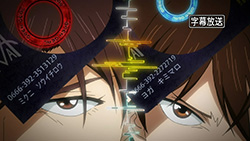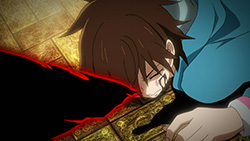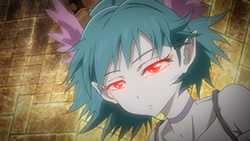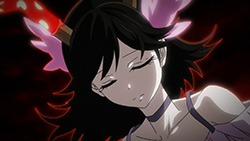 |
 |
 |
 |
 |
 |
 |
 |
 |
 |
 |
 |
 |
 |
 |
 |
 |
 |
 |
 |
 |
 |
 |
 |
 |
 |
 |
 |
 |
 |
 |
 |
 |
 |
 |
 |
 |
 |
 |
 |
 |
 |
「Control(未来)」 (Mirai)
“Future”
Perhaps the crisis became so severe that the situation of the Financial Districts leaked out to the general public, but I’m not sure why the news media are reporting on C when only entres and certain organizations are aware of Midas money and Financial Districts. Regardless, as expected the value of the yen drops severely, with the exchange rate shooting to 3000 yen for one US dollar, which in turn cripples Mikuni and also destroys the value of the Midas money. Unless Kimimaro exchanged all his money before though, he would be in the same situation so I’m not sure exactly how he managed to beat Mikuni. I also think it’s kind of unfair being able to challenge anyone to a deal at anytime, especially outside the usual weekly battles, and also being unable to decline the said challenge without giving up half of one’s assets. It seems that Masakaki is just making arbitrary decisions, but the battle that results really is quite epic and the Pokemon-esque vibes are coming off strong with both sides calling multiple assets and attacks one after the other. That was definitely the craziest fight yet, and Mikuni and Q are incredibly strong as well; Kimimaro didn’t stand a chance without all factors falling into place favorably. Q was very scary, but in the end I think Msyu does manage to turn her against Mikuni, and she takes on Takako’s form just as Mikuni loses and C hits Japan. He admits his defeat, and that moment when Takako/Q disappeared was quite depressing, and he seems to be the big loser here.
In the end they state that they really do want the same ends, but disagree on the means. Mikuni’s methods save people by taking away their futures, but Kimimaro’s side is destroying countless people’s lives as well, and I’m somewhat biased against him because I feel that he really is the selfish one trying to save his own future. Destroying the value of the yen is causing some pretty severe consequences, as it pretty much bankrupts the country along with anyone else who had assets mostly in yen. Either by luck, some stroke of genius, or a combination of both, the whole situation actually turns out alright because of several factors. First off the devaluation of all the currency results in the negligible impact of “C” when it reached Japan. The mechanisms and causes of C are not explained, but from what’s shown it seems that it’s like a rapid financial crash that results in the disappearance of buildings, peoples, and other entities. My guess would be that it has no effect on an already broke country, since what’s already destroyed cannot be taken away; a forest fire cannot happen where there is no forest. In essence though the devaluation of the Midas money itself should have caused the disappearance of a large portion of country at least, but this is covered by the fact that Kimimaro gained a darkness card and therefore can reverse the money presses, though I’m not sure where he gets all the money.
Some of the details of how the money press and the Midas money in general worked got slightly confusing, but after a long discussion with Divine and reworking through all the causes and effects, some of it became more clear. Basically, running the money press in reverse returned all the Midas money (which was also now worthless) and returning the collateral that had been previously lost in deals. Mikuni had exacerbated the problem by printing more Midas money in attempt to save the present, causing the debt to grow ever greater. Because of his extremely widespread influence, his actions that took away many years of his future also had some drastic effects on the entire nation. But with the Midas money worthless now, the loan is also worthless, allowing all the futures to be returned. Kimimaro’s teacher gets his children back, Hanabi becomes a teacher again, and the city lives again. Of course, the process would have almost completely destroyed the present and the wealth of the country, though the scenes in the epilogue definitely do not show the effects of that. It is possible that the prime minister had some sort of back up plan (the “last resort” he mentioned), with a large reserve of USD or something similar that could salvage the economy at least partially. In essence it seems that the world was pretty much destroyed and recreated, with only a few select people remembering the changes and what happened. In the end, nothing about the motives of Masakaki and the Midas bank is really revealed. Though I seriously doubt they are looking out for the best interests of the human race, they do seem to be the masterminds of almost everything surrounding the Financial Districts, and simply play along with the decisions made by the Entres.
Epilogue
 |
 |
 |
 |
 |
 |
Final Impressions:
C was a pretty interesting series and has a very unique premise about finances set in a supernatural world in which “entrepreneurs” put up their futures as collateral and battle each other for money. Like I’ve said before, the fights are not central to the main plot, and the battle system is just a part of the whole. The action is more of a perk, and the battles are indeed very over-the-top with “entres” teaming up with their “assets”, using different degrees of “inflation” as attacks, and bleeding money when hit. The details of those aspects aren’t really delved into, so it can seem underdeveloped and confusing, but perhaps that is for the better. My main gripe with the show was that at times the plotline became quite convoluted, making the logic harder to follow. The first few episodes were mostly set-up, introducing the characters and the world of the Financial District, then the plot inched fairly slowly as the cast and their ideas are developed. In the final few episodes the story suddenly lurched forward and things snowballed at lightning speeds towards the climax, and as result a lot of explanation was left out or mentioned fleetingly, making it important to catch the little details. I’m not really sure what to say, but it does take some time to process what has happened. Overanalyzing everything does take a lot of enjoyment out of watching the series though, and perhaps it’s better to just take a fictional world for what it is.
There are some pretty deep themes that are explored throughout the story, and indeed the battle of ideals between Mikuni and Kimimaro forms the backbone of the show. They both have noble desires and perhaps the same ultimate goal, but with methods that are on two different ends of the spectrum. What made the whole situation so interesting was that there was no clear answer on who was right; save the present so there will be a future, or save the future so there is purpose in the present — living in the moment or for the future. The mechanics of the system makes it a lose-lose situation, but in the end everything does work out and thanks to various factors both the present and future are saved (most of it at least). It wasn’t a surprising way to conclude, but the ending was slightly bittersweet and I’m not disappointed.
C is not a series I would strongly recommend however, unless the premise really perks your interest. Most of the characters aren’t interesting, and I found the protagonist Kimimaro fairly unlikable too. To me, Mikuni and Jennifer stood out the most, and the assets are pretty fun to watch even if they aren’t particularly deep. The story can be a little confusing as anything involving the future can be very vague and hard to explain logically (like time travel), so it’s hard to breeze through all the episodes and understand everything. The themes are quite thoughtful though, even if the characters aren’t. In addition, there are many parallels with real world economics that can be drawn, and the analogies actually run fairly well after some examination.

not sure what happened at the end. people couldn’t see him at the end? if that’s the case then this ending is pretty sad >_<
same, it seemed like hanabi didn’t notice or remember kimimaro, at least that what’s I take from the subs.
Exactly! I also thought that no one can notice him OR at the very least no one remembers him at all, but I think that no one can now see him because for example when he was standing near the electric post in front of the house of the professor (whom lost his kids), one of the kids looked into his direction, but no one was there. Also there were some shots shown where the bench was empty and then back again where he was sitting there. Plus Hanabi could not see him and when he wanted to call her out, he decided not to. So whats the deal here? How in the world can Mysu be his daughter then? Man I really wanted a decent conclusion to this series, not only do we still not get a proper explanation about what Midas money and the financial system really is or for what its purpose is, but we dont even get a proper end to Mysu and Kimimaro’s relationship, are they really father and daughter? or lovers? in the future, i guess no one will ever know. Sigh, the show had a very very awesome start and still have a good setting, but halfway through it just started going downhill. Its really too bad.
I liked watching this series but at the same time the whole thing was confusing and ended in confusion. Good premise for a series but poor delivery. I think it would have been better if it was 13 episodes or even better 2 cors and the economic technobable and rules of the fighting better explained and spread out thru the episodes of the 2 cor season. It seemed like they just threw in rules on the spot and called out attacks from out of their asses. If the show was 2 cor we could have seen him learning each new attack one at a time so we could get used to them (like Star Driver did).
There was a part where Kimimaro’s father called her new born child Mashu/Msyu. Maybe people can’t see Kimimaro because he was a result of a future being lost (Kimimaro’s father’s), and now that future has been recovered (which is Mashu. She would have taken his place as Kimimaro’s father’s daughter). It would be interesting, but I’m not so sure.
Yeah I also wondered about that, maybe she just did not notice Kimimaro? otherwise that would be an end I don’t particularly like…
It’s unfortunate, because this show could have been so much stronger were it given two cours. There simply wasn’t enough time to develop all the characters, nor was there enough time to build up C’s influence on the world. They introduced the concepts to us and then WAM, there’s the finale.
That being said, this was probably the best possible conclusion for C, given its restrictions. Great production values and an overall satisfying conclusion help make up for some of its shortcomings. Though, I’m still not a fan of using blatant exposition to churn out a series’ message, lol
1. omgz, our futures are dissapearingz!
2. let’s make the yen worthless!
3. buy stuff with USD (also, and still, backed by midas money, if you paid attention to the first half)
4. profit!111 (or fridge horror, if this took place before the us housing bubble.)
I really confuse whose house that Kimimaro visit at the end ? looks like Hanabi house but who are those person that come out ?
and I don’t think it’s that teacher’s house and his kids
It’s his teacher’s house.
https://randomc.net/image/C/C%20-%2004%20-%20Large%2005.jpg <—his wife is the same as the family going out of the house.
isn’t his teacher house looks like this http://i1182.photobucket.com/albums/x451/silverkung/senseihouse.jpg in ep 4 and 5 ?
He intended to visit Hanabi but it’s a different family who lives there now. No relation to Ebara sensei since the kanji in the front is not Ebara. I recognize the characters but not the compound.
The news media isn’t reporting on C and the Financial District. The announcer was just talking about the general collapse of the market. At least that’s how I interpret it. The IMF guys can track C since some of them are entres.
All its promise of exploring economics and it ends up a pokemon show complete with the happy ending. I guess greece should start devaluing the euro then adopt the us dollar since that seems to solve all problems and there’s absolutely no bad effects like a depression. Surely the entire EU can see thats the answer.
The insertion of that fella who comes out and says it all for a better future was not just facepalm worthy, it was headdesk worthy as well.
Terrible series for me. Tried to look sophisticated, ended up looking stupid.
Straight out markets and economics gets boring real fast. Any sophistication in markets is only smoke and mirrors to make the uninitiated fork over their money to advisors and funds (they’re just gambling anyway). I like the initial approach the anime took but it’s just unfortunate the 1 season limit forced a quick resolution.
Besides the Masakaki character I also liked how they brought in certain ideas like the attack terms (EBO, pacman def) and other aspects in the plot (QE, helicopters, squid like tentacles). I don’t believe he just made that without doing some research because it’s too much of a coincidence.
As for the PIIGS, some sort of default situation would probably be in their favor, but a large part of it also lies within all the counterparties who are involved in PIIGS debt. They’re going to find ways to kick the can down the road while having no real growth.
Personally I’m short the market so I want to see defaults and haircuts. But I also believe that assets are overpriced due to all the rampant bailouts and stimulus that has happened globally.
Oh really? Smoke and mirrors? Gambling? Sounds like you are advising people to gamble their money away themselves. It’s not gambling, it’s risk and leveraging that risk. If you want to associate it with gambling, then poker is a good analogy, while a professional poker player can sometimes lose, their skill allows them to make more than they lose in the long term.
Anyway, I liked this series because I like anime and I work with others futures as a living. I’m just shocked they has this combination. It was for sure a unique experience for us all.
Poker is a great analogy for investments because it has a lot of the same elements like EV, value of information, cash management, etc. For simplicity’s sake I’ll lump it all into gambling. I’m in the fund industry at one of the TBTF banks; nothing glamorous but at the back office, if you keep an open mind and an eye on the big picture you can see quite a lot. The brilliant, sophisticated fund managers with stellar resumes can lose money just as easily as someone daytrading on his etrade account as a hobby. At the end of the day it’s basically a skimming operation where those in the industry take a little piece of other people’s collective assets. It pays the bills, but I am trying to get out of it.
You don’t need to throw all the lingo like risk management, fundamental/technical analysis, equity ownership, etc. I already went through all that in school. But what we do in our collective industry is far from “God’s work.”
It may be a good analogy only if you invest into a financial pyramid. Otherwise it would just represent risks of shared ownership, institutions stability and delayed (or distributed in time) consumption. By definition, gambling is putting money into some pool which then redistributed based on some, mostly random factors. Investment means that the pool is used to purchase property rights or provide time-distributed consumption for its participants, and the redistribution share is equal to the original contribution of its participant if we count out the market instability (i.e. inflation etc).
Like I mentioned before, you don’t need to throw the lingo at me. I have no probs with finance and the people in it. As long as they don’t ask me for money and don’t tell me how markets are oh so efficient and perfect and noble at allocating resources.
It’s a big trading week coming up. No more QE2 and Greece has to decide what to do with it’s credit card bill. Real financial district stuff is on the line. Who’s gonna open deal.
In poker you receive zero actual ownership rights in exchange for your money. The difference is clear.
Also, if you want to settle on the terminology – if you are “investing ” money into financial derivatives which value merely depends on some statistics and in general have only “pool distribution” effect, you might call it “investment”, but I would call it “gambling”. Investing into financial derivatives of such kind is equal to gambling and not a wise thing to do for most people who need to safeguard their savings.
Sorry, I didn’t read the subs- I couldn’t take my eyes off the action. DX So things are back to normal. (sorta) If the Financial District is back, doesn’t that mean more Mashyu!? I’d love the notion of an OVA or perhaps a sequel even. :]
I rank this 4/10.
reasons:
mikuni
Q
msyu
and all of those [MEZZFLATION],[OPEN DEAL], [YOU HAVE GAIN], [CANNIBALISM], etc.
[OPEN DEAL] [SLEEPING BEAUTY] [MICRO-FLATION] [DIRECT] [DIRECT] [DIRECT] [SWAP]
[MEZZO-FLATION] [E.B.O.] [DIRECT] [DIRECT] [DIRECT] [MICRO MEZZO MACRO-FLATION] [SWAP]
[MICRO MEZZO MACRO-FLATION] [ECONOMIC BLOCKADE] [OVERHEATED ECONOMY] [DIRECT]
[MICRO MEZZO-FLATION] [SCORCHED EARTH] [CANNIBALIZATION] [MICRO MEZZO MACRO-FLATION] [ECONOMIC BLOCKADE] [CANNIBALIZATION] [DIRECT] [DIRECT] [DIRECT] …
[MARKET CLOSURE]
[YOU HAVE CONTROL]
..I love the announcer. Totally brings out the heat of the battle in my eyes. :]
The announcer was my favorite character. Seriously, I kept myself thinking about it and (mentally) repeating these phrases at random situation. It’s just awesome. Every battle in all anime should have some kind of overheated economy!
Right? I mean c’mon, what other show is there that has an epic announcer for battle scenes like that. That originality makes shet all the more better! I’ll have to follow up and favorite the announcer too.
Out of all of his expressions throughout the show… He looks so <3!
The authors of that show are definitely on something heavier than pot. The ending has managed to produce two times more plot holes than it covered.
In addition, there are many parallels with real world economics that can be drawn, and the analogies actually run fairly well after some examination.
The whole show feels like some delusion, with flashing signs and everything alike around, much like in casinos and similar gambling places, but regarding to economy it all doesn’t make sense. It has parallels only with gambling – because of those delusional messages and flashing things, which don’t make any sense – everything just diverts the attention and creates some fake appearance of deep meaning.
I got a very Lovecraftian/Fey feel from the beings behind the scenes of this series. It doesn’t help that they used CG graphics for the non-humans. . .enough CG to look good, but not /quite/ enough to hide the CG.
in the end hanabi choose the childrens : NTR ending~
Need more battles. Im probably gonna miss the announcer and I was right after all they gave the “everyone’s future gets returned” ending.
if you like the announcer pretty sure he did a robot voice for a weapon on of the characters uses in nanoha
Happy Ending, he saved his future, he will have a child, but if his wife will be Hanabi, it remains a mystery.
Not a happy ending, he gave up his future to save everybody elses.
and the financial district is still taking peoples futures.
lets face it, as Prooof said, its just as bad as mikuni’s plan. only extended the deadline.
maybe someone else will come by and extend again, and repeat.
Weird, so the girl in the end is Hanabi? i thought she just a lookalike form what Masakaki said.
Overall i give this show a low rating. It wasn’t that the concept and stuff is not good, just that the animator have too few episode to work on(they can’t even portray the battle properly).
5/10
That because it actually pique my interest in knowing the continuation of the story but unfortunately having 2nd season of this has as much chance as getting a lottery.
“but I’m not sure why the news media are reporting on C when only entres and certain organizations are aware of Midas money and Financial Districts”
They weren’t specifically reporting on C, but how the market was affected by the downturn in the other markets that survived C. And the trillions in yen that popped up out of nowhere thanks to this guy :3
Kimimaro’s amazing Falcon Punch was a bit Gurenn Lagann-esque – it’s like the style’s becoming the new ‘Ultimate Protagonist Finishing Melee Highlight‘.
As for the wonderful Miss Satou… She needs her own spinoff series. Explaining to us the workings of C. Preferably with gratuitous fanservice. And fries with that.
Alright, to explain the ending. He gave up his future (Msyu = Hanabi) to undo the printing press of the black money. That’s why at the end of the show, Hanabi didn’t recognize him. Kinda wierd because you’d think by giving up Msyu, Hanabi would’ve disappeared but instead Hanabi’s memories of Kimimaro is gone. Maybe it had something to do with how the Yen became a dead form of currency, but what I didn’t understand was how did everything revert to normal like nothing happened. Since the Financial District still exists I’m assuming Japan became part of the US seeing as how they use the USD as currency.
Msyu != Hanabi
http://www.noitamina-control.jp/05story/index.html
Hit the play button.
I don’t get what this post is about. Are you trying to agree with my post about Msyu = Hanabi?
Sadly I can’t understand japanese so if a slight translation can be offered, I’d be much greatful.
It means Msyu is NOT Hanabi.
Someone apparently subbed the thing (and the part that is relevant is correct) so i’ll leave it here
http://www.youtube.com/watch?v=Cmp_6GvbUtI&feature=player_embedded
Now that big kiss on the lips (hinted) takes on a different dimension eh?
True it states a “certain college student” but that doesn’t necessarily mean Kimimaro
Well, who is Masakaki referring to then? A generalised case just like when he refers to a “powerful Entre with a sister asleep”?
I’m just saying, you never know.
Why is Msyu = Hanabi ? I thought Msyu is his daughter or something, can you explain their relationship? You said because Msyu disappear , Hanabi memory is gone. Based on the same logic then it should be if Msyu haven’t appear yet, Hanabi should not know Kimimaro. But they do know each other. If everything above is just your speculation with no reference, it fine. I wanted to know how you reach that verdict too.
Throught the series if you pay close attention to the facial features of Msyu and Hanabi are somewhat similar, especially towards the end. It can be the same with Q and the guy’s sister. Also, Msyu disappeared in the ending and Hanabi’s memory was lost in the ending, they knew each other throughout the show except towards the end where the money press was started. As more money was made, the Entre’s got weaker which made Hanabi’s memories of Kimimaro fade.
Catch my drift?
I got it! Interesting theory, well they never really explain much about relationship between entre,future,midas money and asset well. And judging from things, it will never see the light since they won’t be making 2nd season of this. Hope some sort of manga will spawn to explain these stuff ( unlikely though )
@PandAEmic:
In most cases, the only defining features of an anime character are their eyes and hair. I really think you’re really grasping for straws here with this facial feature thing.
I really don’t think this is correct. Msyu is definitely Kimimaro’s future daughter or granddaughter, just like that Masakaki monologue clip suggests.
What Kimimaro exchanged to get everyone’s futures back was all the worthless Midas Money. He ran the press in reverse and took all the Midas Money out of circulation, so Masakaki had to return all the collateral.
What does Masakaki monologue said? I don’t understand japanese, so if it is raw please just give me rough summary.
I found it clear whose method was right. Mikuni’s sister wanted to stay in present, in that day because she knew she had no tomorrow. When we first saw Hanabi, she was cheerful, full of life, then she lost her future, her interests, she did nothing but sit around. And her future changed as well, she wanted to be a teacher, but not a kindergarten teacher (or I missed something). It’s like living without a purpose is futile, so Midas Money/going bankrupt made people without reason/resources dissappear. The sad thing here is that through the entres’ eyes we saw, what effect money really has. In nutshell, IMO.
a bit deus ex machina ending, and I’d like to see some explanations…
why C bypassed Japan? switching to $ seems connected…
what became of Mikuni/his sister/photographer info dealer/miss fries?
with Midas bank still out there, wasnt the whole deal (incredibly lame pun…) in vain?
Well the reason why C bypassed Japan is because with the Yen being worth nothing, essentially japan didn’t go bankrupt seeing as how they had nothing to lose in the first place. As the photographer said, money is all about trust. Without trust a dollar bill can be worth nothing.
As for the people you want to know about, it doesn’t really matter. They all got lost in the financial district. All you need to know is that the only person effected really was Kimimaro and as for the midas bank thing, just a guess, but what I think is that it wasn’t in vain. It was a metaphor about people’s trust in paper.
Actually because the yen is worth nothing, japan IS basically bankrupt.
All imports are hit as the price of a cabbage rises to many times that of normal (if the yen is even accepted by the foreign country from which stuff is imported). Since japan imports a lot of its meat, non-rice grain, ore and other raw materials, this will pretty much devolve into a scene where japan cannot pay for its needed imports.
Since imports are out, the existing supply will be strained by the increased demand, resulting in vastly inflated prices, including possible hyper inflation.
The japanese govt will be forced to use a (large) part of its foreign currency reserves to repay its non-yen denominated loans unless its willing to default, resulting in a smaller pool of foreign currency that can be used to either help solve the crisis or simply buy time by drawing on the pool to pay for imports
The entire “C bypassed japan” is just simply something pulled by the writer because it could not be solved given the entire “crash the yen” idea
What has import has to do with the value of the internal currency of the country ? Have you tried learning at least something about economics ? Search google for ECU and read about it then.
Gosh … People are trying so hard to look smart
Zaku is singling out an aspect of foreign exchange. Use oil as an example. Japan has to buy oil from other countries. Normally to do that, they would just exchange JPY into USD (USD is the reserve currency) and get oil from the Saudis. Now in ep 11, the JPY has been devalued at one scene to be 3000 JPY/USD. So in order to get the same barrel of oil you either fork over the 3000 JPY/USD or you have some non-yen currency in hand (central banks do this).
Oil is an input in a lot of costs of production so if you’re making melon bread, even if all the mats are produced in Japan, they still have to get to your bakery. That takes oil (directly or indirectly). In order to pay for the increased costs of bringing those mats over, you’re going to increase the price of your end product melon bread.
Take every input not originating from Japan and do the same thing you end up with hyperinflation. And this is with 3000 JPY/USD. As the ep progressed that value is basically inf JPY/USD or nothing and the Japan is bankrupt.
There is a mistake – they use their local currency as a payment media, but they actually pay with the goods or services exported. The yen itself has close to zero value without those goods.
I don’t think so. JPY like all other fiat currencies are tied to trust. That was explained pretty well in the anime actually which is part of why I liked the series.
It is tied to trust as a choice of many people to use it for exchange purposes. They still have to pay for everything with goods or services.
I take part of that back. You’ll need the export aspect of the trade to close the account. This goes back to my oil example. In order to eventually pay for the oil Japan would need to make and send out something like PSPs and hentai goods. Zaku’s point focuses on the import part of foreign exchange. It doesn’t change that JPY is a fiat currency.
Hmmm, trade imbalance is one of main problems facing US economy, with vast deficit created by imports from China (Walmart!) and oil (Middle East, Mexico, Venezuela).
IDK how the trade balance is in JPN, but it seems they have been doing not bad with all the Toyotas, Suzukis etc. exporting, and electronics goods like Sony. Quake crisis can affect that though.
OTOH JPN has huge import needs, from foodstuffs to almost all of its oil. (they tried to overcome this before by capturing colonies with resources… it didnt work so well – with the WW2 results and all…)
We could use a bonus episode using Miss Fries to infodump us on story behind ending. Masakaki showing up again probably represents eternal human nature regarding investments and gambling own future… BTW, isnt that allusion to the futures market?
http://en.wikipedia.org/wiki/Futures_exchange
You can look here for Japan’s current account balance.
http://www.indexmundi.com/japan/current_account_balance.html
I think Japan has been doing relatively well. In terms of investing I haven’t really paid attention to them in the past few years. The main themes that come up is usually slow growth, deflation and the aging population.
As for the futures market I don’t think the financial district is a direct allusion. I think it could work for markets in general. I mentioned in a post in a previous ep that assets includes retirement savings, insurance, mortgages, credit card debt and investments. Even if you don’t personally invest your various assets, someone out there is doing it for you. And, their gains and losses will affect your life.
I suppose only the futures of the people that were still alive were returned? Otherwise wouldn’t his dad come back?
I don’t know why, but I got a real kick out of seeing everyone using American money. I mean I still don’t get the show and some of it was hard to watch, but it was all worth it just to see that scene.
Oh great economics guru SpoilerMaker, please tell me how imports are paid for and how a crashed local currency impacts foreign exchange rates?
The exchange between the countries can still take place when they use another currency or some sort of international currency unit – in this case there should be the respective institutions to deal with it.
The import can be paid in any international currency remaining. The formal prices in internal currency of the country can be recalculated each time as spot prices (using indexes).
If the currency suddenly crashed, there would be a lag necessary to change the contracts to some other “currency” value (such events belong to force majeure category clauses of the foreign contracts), but after the transition to another currency or some international currency unit the trading will continue.
What else do you want to know ?
Oh great economics guru SpoilerMaker, please tell me
i) if the exchange rate of your “another currency” rises or falls vs the local currency unit.
ii) how a rise or fall as mentioned in i) will impact the local economy
iii) the roll down effects of ii)
2) There may be many effects depending on the features of the international exchange process of the particular countries. If the international trade balance (in actual value) of export and import is about the same, there would be just some lag to move to another way of payment. In the contracts you would be still able to put some arbitrary nominal value in the local currency, which would be just formal, as you would be willing to trade one thing to another at their actual value using a nominal number to indicate its value.
The second lag may be caused by the influence of budget income from foreign trade to the overall country budget. It would take some more time to introduce new regulation in favor of another currency.
After the lags the trade may be resumed in its former scale.
Oh great economics guru SpoilerMaker, please tell me
i) Will the import rise or drop in cost in local currency?
ii) What is the effect if said imports are essential goods?
iii) what is the rolldown effect of ii)?
1) The nominal value in the local currency would not make any sense for some time. The formal result is not predictable, it depends on the nominal values specified in the contracts. The answer is – the result becomes undefined when expressed in local currency.
2) The import will still continue for some time, then it would drop, then depending on how fast the transition to another way of payment is, it will return to its former value providing that the import is not greater in its actual value than the export (for some prolonged time).
3) Define what you mean under rolldown effect – many things can be put under such category. Are you talking about stock market or macroeconomics ? The effects may vary and do not necessary depend on the nominal value of the currency, but rather on the political decisions, legislation and actual economy outside banking sector.
Oh great economics guru SpoilerMaker, please tell me
i) The cost any consumer pays for the imported good rises or falls?
ii) Impact on local production when raw materials are imported
iii) Impact on ii) on exports
iv) impact of iii) on the balance of payments
1) Some will pay more, some will pay less (those who have only local currency, will pay more, those who have other currency and some actual good to be exchanged, will pay less).
2) Depending on the reserves, if they manage to move to another way of payment before the reserved goods are depleted, the production would remain the same. Most of production facilities which do not have enough supplies, would suffer.
2.1 If the company is directly managed by foreign investors and produces goods for export, it can remain unaffected.
2.2 If the company produces high demand goods, it may continuously reindex their value and even increase production due to temporary increase in demand.
3) Depends on the structure of exports. Export can be made in other international currency (already mentioned).
4) Rise of export in case of low inflation, unpredictable (depends on the structure) result in case of hyperinflation.
Oh great economics guru SpoilerMaker, please tell me (even though obvious attempts at evasion are done)
i) Have you answered your own question of “What has import (sic) has to do with the value of the internal currency of the country?”
ii) Feeling very guruish now?
All imports are hit as the price of a cabbage rises to many times that of normal (if the yen is even accepted by the foreign country from which stuff is imported). Since japan imports a lot of its meat, non-rice grain, ore and other raw materials, this will pretty much devolve into a scene where japan cannot pay for its needed imports.
1) You assumed that the change of the local currency value would stop the imports of the mentioned products (raw materials), i made the point that it would just require changing the way the payments are made, since the question directed specifically to you.
2) No, just having fun arguing when people show some lack of knowledge. At some other place arguing would be meaningless because the potential opponents would know the subject as well.
And there was hardly any evasion, reviewing every single possibility to provide a complete answer would take way too much time just to type it all. I prefer to limit the size of the text i have to type.
1) You assumed that the change of the local currency value would stop the imports of the mentioned products (raw materials), i made the point that it would just require changing the way the payments are made, since the question directed specifically to you.
Sadly you were the one assuming and failed to see further on the full impact. You’re entire idea hinges on the balance of payments being neutral and shifting to a subsitute currency but fail to include the impact on the local economy which rolls down onto the actual trade balance. Another failure was to notice that the goods noted were essential goods or basic goods.
If you wish i can continue with tearing down your evasions on “undefined” and “unpredictable” things.
I do not like to include undefined factors and make some statements based on their total mass. If i count them in, i would be making a mistake, because the result may vary. It is a way to avoid the mistake.
The local economy may be quite big, it may different sectors, in particular export-oriented. Depending on the particular ratio of the sectors, the result may vary.
What i see from you side is an attempt to force me into making some assumptions based on some unknown situation with unknown structure of balance, export and import. If i give some definite answer about the whole state of some economics which is not defined by definition, i would be making a mistake.
As for the essential goods, most of states (starting from 19th century) keep some quantity of them as some sort of insurance, reserve to protect themselves from short-time market instability. Depending on the amount of the reserves, it may be enough to withstand a transition to another form of payment. Also, many foreign suppliers would not cease the shipments instantly, they would prefer credit relations and some time delay to move to another form of payment, because they are not willing to lose their export sector.
If you like, keep on “revealing” my “evasions”, i would be still unwilling to give false estimates of something with the structure unknown by definition.
Ah so your entire idea is that “everything unknown thus there is no conclusion”. Ignoring japan’s ministry of finance actually provides statistics (imagine that!), well that excuse works as well as low inflation in a currency crisis
In my answers i mentioned known situations and cases as some selected few out of great variety of the available factors, including opposite effects. And now, are you talking to some specific statistical data ? Let’s discuss the exact numbers from the statistics then, it would be indeed easier to give quite specific answers given the particular numbers. When we take Japan statistics, a hypothetical situation of hyperinflation will just give different results (yes, including totally opposite ones) in different sectors of the national economy, and the result would also depend on the particular actions taken by the government and the existing market infrastructure.
correction: talking about
I was just about to say “great, then go and resolve those so called ‘undefined’ and ‘unpredictable'” until i saw particular actions taken by the government which would be another escape clause for “no conclusion” since one could presumably cough up many excuses
No, it would just require selecting most “popular” actions for the answer, it just means that there would be given a few answers (much like in some previous answers) instead of a single one.
Well then go ahead and resolve your “unknowns”. Data for 2009 is freely available if you’re worried that certain 2010 statistics have not been compiled. Additionally, I would love to see how you manage a low inflation when the currency goes to 37.5 times (~1:80 vs 1:3000) without resorting to a managed economy
Managed economy is the right way to stabilize the market if it has no ability to stabilize itself, I don’t see it as something wrong.
Back to the data from 2009 – what is your question about the estimates of hyperinflation results ? Specify the source of hyperinflation and period. Keep in mind that the supplies of the most important goods would be enough for about 2-3 months if we take data from that period.
You did notice that this is about C, so obviously the cause of the currency crisis is that someone is throwing money from helicopters, LOL!
Unlike C, real economics have no magic rotary press so taking the history of the argentine example, lets say 3 years. Do remember to factor the services sector.
Ok, taking real data from 2009 and sudden (out of nowhere ?) hyperinflation, the possible scenario is that the government may try to use a part of its foreign currency reserves for the first 2 months in attempt to stabilize the local currency combined with control over banking system. Mind the difference in the amount of reserves in Argentina and in Japan – it means that the collapse of the financial system will not result in immediate shifts in import structure and volume. For the first 2 months the country wouldn’t even need the internal reserves of the most important goods. Even after 2 months of crisis the import would still be close to its previous volume, at the cost of foreign currency reserves and delay in the contract terms. After 3 months it is possible that the internal demand for the most important products would grow, which would result in short and temporary increase of the import in that sector and there may be a need to use the internal reserves of such goods, which would be enough to last up to 5 months from the start of the hyperinflation. From 4th month the import in that sector may decrease, but the companies would start shifting to other ways of payment, which would cause a temporary decrease of total export and import amount from 5 to 7th month from the beginning. In about 9 months (enough reserves to last that much) the government would be forced to introduce managed economy and regulate import and export based on the economy needs (some sort of budget for export and import, it historically was present in similar situations). After 10 months the industrial sector may recover due to transition to other ways of payments, within managed economy. If the export and import volume and income regulation is introduced in time, the sector of most important product import (food etc) may recover in 12 month after the beginning. That would take about 1.5 year to move to a managed economy with a substitute currency, after that the actual value of export and import may be back to its previous level, if the government manages to stimulate the internal demand (and save the savings of the citizens). In less than 2 year the situation would recover, regardless of the hyperinflation.
I think it is enough for an answer, taking into account the amount of reserves and structure of import Japan has (which excludes the scenario of some less developed country you mentioned). There would be no immediate collapse of the economy or some major changes in the total value of export/import (major = over 50%). That is if the government takes the right actions, and the case of default is very unlikely.
And about services sector – many sub-sectors of it won’t be affected once the reindexing is introduced. It depends more on political, ecologic and other factors which can’t be “fixed”.
Also, if you mean the financial services market, the structure of banking system in Japan is different from Iceland, it means that Iceland scenario is not possible there.
Now i know for sure you don’t know anything nor are you even trying. Your numbers are completely off even after i pointed out relevant statistics are available. I pointed out the services sector simply because it is a direct casualty in a currency collapse. You failed to take the initiative to find out what the actual, and very large, foreign reserves of japan were nor considered the vast majority of governmental debt being local denominated. Even the commmon fact of japan’s gobalised manufacturing chain and JIT practices were ignored.
Sorry i’m not interested in spoon feeding people.
You failed to discuss any actual data or outcomes or theory details and limited your void talks only to emotional attitude which again proves your actual “knowledge”. Moreover, your attempted to shift the discussion to some undefined areas, in which you claimed to have all-time-working conclusions. Maybe spoon feeding yourself with some basic data about economic unions and internal transactions of international corporations might even work for you before you are able to argue about something.
Also, you didn’t even mention the the particular role of the government in the monetary regulation, while initially there was a severe assumption about the dependence of monetary regulations on some weird gambling institution instead of the respective government institutions.
No one mentioned this major mistake here, while it it would be clear for anyone who had some extensive practice in the area. It is interesting to observe the people following the assumptions which are fake from the very beginning. I case if this discussion goes on, i still have a few major stupid assumptions to be discussed, but it was interesting to see if some people here have the knowledge (and are willing) to discuss that. It was fun to wait for some more or less “persuasive” reasons on the topic though.
It was far from the best series of the season, but it was pretty decent, I liked it.
Really nice show, even thought I didn’t understand half of it because my lack of financial knowledge. LOL.
The people with enough financial knowledge didn’t understand it either, because of lack of anything actually financial in the show (it doesn’t make sense).
Agreed! They don’t really have any real business logic integrate into the battle, just simply using names that sound cool related to business.
Guys guys. The girl at the end is NOT HANABI. It’s mentioned by the hat guy “looks like” only. Even Kimimaro turned away when he realised that the girl is NOT Hanabi.
So no Hanabi is not a teacher.
wakannai. I don’t understand. It was a horrible and sad ending for kimimaro.
Kimimaro has become invisible to all human beings. how is he going to live? This kind of reminds me of Lain at the end where she can travel through time and can appear and disappear at will but it looks like kimimaro will be alone unable to be seen for the remaining of his life.
Simple Summary He pressed the RESET BUTTON.
It is the happy ending! They destroy the midas money value (that was in yens) and Kimimaro buys back the future. The market closed (“market closure” said the cool announcer), so C didn’t have any effect on Japan. And the financial district, that traded yen for future, had to close because his yen equaled nothing. Without trust it was just paper.
And Kimimaro is not invisible and he has his future. As proof, Masakaki would not have offered him to return to the restarted financial district if Kimimaro didn’t own a future as collateral to trade.
Him disappearing of the house was that he didn’t see Hanabi and so he went away, and the school teacher just resembled Hanabi so it is normal she didn’t recognised Kimimaro.
Kimimaro is free to go on in this new future.
Oups, he did not say market closure, it was just written
Mad disturbing images, I just realized. The art was crumpin’ this episode.
It almost seemed like the conclusion wasn’t explained enough but still was a pretty good and unique show.
I have a feeling we might get a second season explaining the whole deal about financial districts…
So the world is still gonna end eventually?
So is Kimi alive?
One of the few series where the last episode gave me ton more questions than whole series ever did! lol
“nothing about the motives of… the Midas bank is really revealed.”
It’s been a few days since I watched the episode, but as I recall (and assuming my subs were correct), didn’t they basically say in the angelic scene at the end that the entity or group in control of Midas Money purposely inspires conflict between people of conflicting ideologies for the sake of a better world?
It would also explain certain seemingly ass-pulls like Kimimaro’s receiving a dark card and the mandate for battle upon challenge.
“I seriously doubt they are looking out for the best interests of the human race”
yes I remember that scene, but it feels like they are just messing around with humans
like Masakaki said in the end, as long as there are futures to take, they are happy
[M-M-M-M-M-M-Macroflation: Overheated Economy] *FWOOOM* That was fun! 😀 Can we do it again o3o?!?
Week in and week out I loved the economic techno-babble. Yeah, there’s a serious hole here and there, BUT THERES A HUGE FREAKING battle going on in front of you. Ooooh Shiny. Most series like this play by their own rules than by the actual rules of reality, so I don’t see the need to worry about it too heavily. If they tend to play by their own rules, cool. If they break their own rules left and right, well crap the show is probably going to suck.
Overall it was great. Another story of the Future vs the Present. Moving on vs Standing still. And Takahiro Sakurai as the mysterious Masakaki was continually entertaining ^_^. I look forward to marathoning this in the future when I need some shounen battle spirit, and a really silly Sakurai.
This show surprised and disappointed me a bit with the line art battle finish. It feels overdone after TTGL and Star Driver. I wish they would’ve tried for something unique, but oh well. What’s done is done. Onto the next Noitamina shows! I haven’t yet to be severely disappointed, and Usagi Drops is looking to keep it that way. >D.
I got mixed feelings, I really liked the idea behind the show, but it was too rushed with too many unanswered questions and a BS deus ex ending. Ok, to focus, I really liked it at the beginning, the idea of how money/economy can influence our daily lives and how we would react to having a chance to shortcut to getting rich by making a deal to allow our futures to be mortgaged as collateral. An interesting premise and one I think could have been handled better. I liked that the assets were manifestations of the future of the individuals but I really hated the pokemon battles and think a more interesting system could have existed.
One of the problems right of the bat is that the main character is unlikeable and seems pretty selfish. He is the annoying type of anime character who does not plan anything, but just goes with his emotions (I want to protect ____) regardless of the consequences, but who anime seem to love pulling out a deus ex solution that solves all the problems magically. One very missed opportunity was to show how money would effect the main character. He never changes his routine, he is suddenly rich but never does anything, to show how wealth can change people and how those around you react to it.
Then we never learn what really happened with the main characters father, his asset, why she looked like his current asset. Is she really his future daughter? Why do some people have multiple assets? What would the main character lose if he went bankrupt? Why there seems to be no fixed rules in battles? Shouldn’t “C” have crushed japan when the economy crashed? There was no way for the main character to buy back the future with the little bit of money he had (BS DEUS EX SOLUTION!!!),If the midus district is immortal, what the hell was the point of “winning” since someone else will restart the cycle, etc, etc
I have a real problem with the ending, Mikuni was not a villain, he was trying to save japan, even if it meant sacrificing peoples futures. He didn’t have the luxury of time and had to move fast. Kimimaro only argument is that he doesn’t like it and fights mikuni without a real plan. Oh, crash the yen and put everyone out of business. yup, great plan. What they should have done is show the consequences of kimimaro’s plan by having japan be worse off than mikuni’s version, BUT have a way where both of them figure out a way together to solve the problem. Personally, the show is about economy, I would use an economic solution. Instead of putting all that money into government/corporations. I would use that money to open NEW jobs, help put schools, hospitals, etc in areas with heavy financial problems. Once people get money, they will spend it at other places and the economy will grow. However, thats just me.
[LAME PUN COON ACTIVATED]
What did Masakaki told Kimimaro at the park?
“I C what you did there!”
Who took the picture, Masakaki? Where is Georges?
Not bad, it was like a summer movie. Not a masterpiece, just enjoy it.
6/10
The Good: Nice Music (OP, ED and BGM), Assets are fun to watch, Mikuni is a great character and Masakaki a total creep.
The Bad: Unstable art, bad use of Cell Shading, lacks rewatch value.
with all that was one of the best shows in spring season
had alot action and some unique story
They should make a live action adaptation of this in Hollywood.
Hire Johnny Depp!
I somehow remember a certain other show starting with the letter C that started great and went down the shithole later…except this show is even more convoluted and bs than code geass.
Premise is interesting and beginning eps presented the whole Midas money system well without delving into unnecessarily complex ideas but halfway through… I don’t even know what happened…
Maybe its just me being picky since I happen to be a finance/political economy major but this show explains nothing. I still don’t get what ‘C’ is… a market fluctuation? It certainly doesn’t behave like one. How the hell did the US bounce ‘C’ back? How did the yen get devalued? (a couple internet rumors and throwing some bills out of a helicopter is NOT going to kill a currency). Besides which, a weaker currency tends to help export based economies like Japan. Most of Japan’s national debt is domestically owned btw so the debt picture isn’t negatively affected by a currency crisis.
I take even more issue with the “themes” presented or more like the lack thereof. Still don’t get why Mikuni and Kimimaro are fighting it out. More like, wtf is kimimaro doing? Mikuni has a clear argument: “screw the future if we don’t have a present.” Whereas Kimimaro is doing what? Sacrificing the present to save the future? Thereby dooming Japan to the same fate as Singapore? The whole “C” passed through idea is bs. You’d still feel the reverberations of a market crash with a weak currency. In fact… its a double whammy, pretty much all of your assets just got devalued.
I would have preferred it if they chose to focus on the effect on the real world of Midas money over all this bs. No idea what the writers were thinking. Battle scenes were forgettable… maybe give this series a 6/10.
Yes, it doesn’t make sense. The authors probably only saw the flashy gambling institutions, and thoughtlessly used some economic terms to make up the plot. So the whole “financial” system in the show is just a overblown image of a large casino, where the people lose their futures by the means of gambling (be it “money” or coins or whatever else as a tool for gambling), and the casino feeds on that. Everything beyond that simple explanation is sick fantasy or delusions of the authors in attempt to make it look like some financial system. Every single thing look just as pointless as in casino.
To make it worse, no one of the characters seemed to have intentions of destroying the casino itself, they just participate in the gambling process.
This series had potential, but did not deliver. The main character was clueless from the first to the last episode, a rarity in anime production. At the end, he just wanted to please his dream girlfriend, which made him as selfish as his rival. Granted that he did show some compassion towards other people. But, in general, he just acted on emotion and helped whoever made him feel sorry at the moment, and didn’t really fight for ideals like other more serious people in the story.
That was a satisfying ending for me. It kinda show you just how much money and international currency can affect peoples lives. I think I understand the whole “Future Collateral” thing a little better now.
The show was great, or near that, until that ending, full of bs, arrived. As I feared, a sappy happy ending (with Deux ex Machine literally!), where everyone’s happy at the expense of the main antagonist. The problem is the guy is no antagonist whatsoever, he’s the only sane character with some semblance of common sense there (not to mention the only really developed one), with the rest being stupid clueless selfish kids, especially it goes for the main protagonist and the big boobs.
And there’s also the fact that no country can be happy with the demolished national currency, so no, there can be no joy and bubbles and rainbows, no kids running around, no walks in the clean parks, no picnics and no smiling faces, only despair, despair and more despair.
Also, shitload of loose ends left, like Kimimaro’s father, his asset, some guys chasing Satou and Yoga, 1/10 of Mashu’s stock that Mikuni owns, etcetcetc. In the end we’re given no clue to even coherently determine if it was Hanabi in the end or not, not to mention everything else. They never even said anything about what became of everyone else, except for Yoga (and even that is no so clear).
Cope out, bs, Deux ex Machina – that’s what the ending of C is.
very confusing anime.
Towards the end Takedazaki gave off a Masakaki vibe.
The anime felt like a sufficiently completed framework to hold up the concept of “present or future”.
Were the episodes planned at 11 or its unplanned?
If it was profitable it could have expanded to other media and perhaps have its mysteries unveiled in manga, novels or games perhaps?
Anyway it seems like the Midas money and Midas cards are made into anime goods:
http://eshop.fujitv.co.jp/fulldesign/B007041/B007041-1.html
Makes me want to get myself a Midas card 😛
From the eshop site, it seems like the Midas cards have a class system of sorts:
Normal, Gold, Platina, Darkness
(Should be old news as I don’t regularly update myself)
Kind of explains how Kimimaro’s card became a Darkness card.
Some kind of level up.
A second asset being entrusted to him.
Trust.
shitty ending..